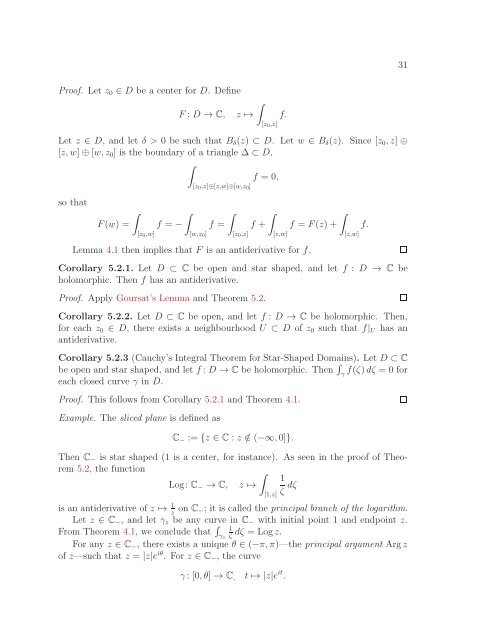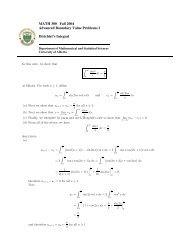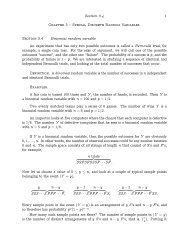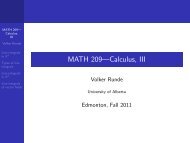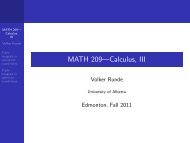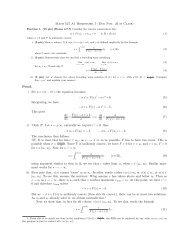Math 411: Honours Complex Variables - University of Alberta
Math 411: Honours Complex Variables - University of Alberta
Math 411: Honours Complex Variables - University of Alberta
Create successful ePaper yourself
Turn your PDF publications into a flip-book with our unique Google optimized e-Paper software.
Pro<strong>of</strong>. Let z0 ∈ D be a center for D. Define<br />
�<br />
F : D → C, z ↦→<br />
Let z ∈ D, and let δ > 0 be such that Bδ(z) ⊂ D. Let w ∈ Bδ(z). Since [z0,z] ⊕<br />
[z,w]⊕[w,z0] is the boundary <strong>of</strong> a triangle ∆ ⊂ D,<br />
�<br />
f = 0,<br />
so that<br />
�<br />
F(w) =<br />
[z0,w]<br />
[z0,z]⊕[z,w]⊕[w,z0]<br />
[z0,z]<br />
� � � �<br />
f = − f = f + f = F(z)+ f.<br />
[w,z0] [z0,z] [z,w] [z,w]<br />
Lemma 4.1 then implies that F is an antiderivative for f.<br />
Corollary 5.2.1. Let D ⊂ C be open and star shaped, and let f : D → C be<br />
holomorphic. Then f has an antiderivative.<br />
Pro<strong>of</strong>. Apply Goursat’s Lemma and Theorem 5.2.<br />
Corollary 5.2.2. Let D ⊂ C be open, and let f : D → C be holomorphic. Then,<br />
for each z0 ∈ D, there exists a neighbourhood U ⊂ D <strong>of</strong> z0 such that f|U has an<br />
antiderivative.<br />
Corollary 5.2.3 (Cauchy’s Integral Theorem for Star-Shaped Domains). Let D ⊂ C<br />
be open and star shaped, and let f: D → C be holomorphic. Then �<br />
f(ζ)dζ = 0 for<br />
γ<br />
each closed curve γ in D.<br />
Pro<strong>of</strong>. This follows from Corollary 5.2.1 and Theorem 4.1.<br />
Example. The sliced plane is defined as<br />
f.<br />
C− := {z ∈ C : z /∈ (−∞,0]}.<br />
Then C− is star shaped (1 is a center, for instance). As seen in the pro<strong>of</strong> <strong>of</strong> Theorem<br />
5.2, the function<br />
�<br />
Log: C− → C, z ↦→<br />
1<br />
ζ dζ<br />
is an antiderivative <strong>of</strong> z ↦→ 1<br />
z on C−; it is called the principal branch <strong>of</strong> the logarithm.<br />
Let z ∈ C−, and let γz be any curve in C− with initial point 1 and endpoint z.<br />
From Theorem 4.1, we conclude that �<br />
1<br />
dζ = Logz. γz ζ<br />
For any z ∈ C−, there exists a unique θ ∈ (−π,π)—the principal argument Argz<br />
<strong>of</strong> z—such that z = |z|eiθ . For z ∈ C−, the curve<br />
[1,z]<br />
γ: [0,θ] → C, t ↦→ |z|e it .<br />
31


